[English] 日本語
 Yorodumi
Yorodumi- PDB-1qzx: Crystal structure of the complete core of archaeal SRP and implic... -
+ Open data
Open data
- Basic information
Basic information
| Entry | Database: PDB / ID: 1qzx | ||||||
|---|---|---|---|---|---|---|---|
| Title | Crystal structure of the complete core of archaeal SRP and implications for inter-domain communication | ||||||
 Components Components | Signal recognition 54 kDa protein | ||||||
 Keywords Keywords | SIGNALING PROTEIN / Signal recognition particle / SRP / protein targeting / SRP54 | ||||||
| Function / homology |  Function and homology information Function and homology informationsignal recognition particle / signal-recognition-particle GTPase / 7S RNA binding / SRP-dependent cotranslational protein targeting to membrane / GTPase activity / GTP binding / ATP hydrolysis activity Similarity search - Function | ||||||
| Biological species |   Sulfolobus solfataricus (archaea) Sulfolobus solfataricus (archaea) | ||||||
| Method |  X-RAY DIFFRACTION / X-RAY DIFFRACTION /  SYNCHROTRON / SYNCHROTRON /  MOLECULAR REPLACEMENT / Resolution: 4 Å MOLECULAR REPLACEMENT / Resolution: 4 Å | ||||||
 Authors Authors | Rosendal, K.R. / Wild, K. / Montoya, G. / Sinning, I. | ||||||
 Citation Citation |  Journal: Proc.Natl.Acad.Sci.USA / Year: 2003 Journal: Proc.Natl.Acad.Sci.USA / Year: 2003Title: Crystal structure of the complete core of archaeal signal recognition particle and implications for interdomain communication Authors: Rosendal, K.R. / Wild, K. / Montoya, G. / Sinning, I. | ||||||
| History |
| ||||||
| Remark 650 | HELIX DETERMINED METHOD: Authors determined | ||||||
| Remark 700 | SHEET DETERMINED METHOD: Authors determined |
- Structure visualization
Structure visualization
| Structure viewer | Molecule:  Molmil Molmil Jmol/JSmol Jmol/JSmol |
|---|
- Downloads & links
Downloads & links
- Download
Download
| PDBx/mmCIF format |  1qzx.cif.gz 1qzx.cif.gz | 153.4 KB | Display |  PDBx/mmCIF format PDBx/mmCIF format |
|---|---|---|---|---|
| PDB format |  pdb1qzx.ent.gz pdb1qzx.ent.gz | 118.3 KB | Display |  PDB format PDB format |
| PDBx/mmJSON format |  1qzx.json.gz 1qzx.json.gz | Tree view |  PDBx/mmJSON format PDBx/mmJSON format | |
| Others |  Other downloads Other downloads |
-Validation report
| Summary document |  1qzx_validation.pdf.gz 1qzx_validation.pdf.gz | 420.9 KB | Display |  wwPDB validaton report wwPDB validaton report |
|---|---|---|---|---|
| Full document |  1qzx_full_validation.pdf.gz 1qzx_full_validation.pdf.gz | 535 KB | Display | |
| Data in XML |  1qzx_validation.xml.gz 1qzx_validation.xml.gz | 36.4 KB | Display | |
| Data in CIF |  1qzx_validation.cif.gz 1qzx_validation.cif.gz | 50.6 KB | Display | |
| Arichive directory |  https://data.pdbj.org/pub/pdb/validation_reports/qz/1qzx https://data.pdbj.org/pub/pdb/validation_reports/qz/1qzx ftp://data.pdbj.org/pub/pdb/validation_reports/qz/1qzx ftp://data.pdbj.org/pub/pdb/validation_reports/qz/1qzx | HTTPS FTP |
-Related structure data
| Related structure data |  1qzwC  1j8mS S: Starting model for refinement C: citing same article ( |
|---|---|
| Similar structure data |
- Links
Links
- Assembly
Assembly
| Deposited unit | 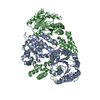
| ||||||||
|---|---|---|---|---|---|---|---|---|---|
| 1 | 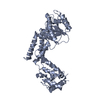
| ||||||||
| 2 | 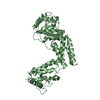
| ||||||||
| Unit cell |
|
- Components
Components
| #1: Protein | Mass: 49463.430 Da / Num. of mol.: 2 Source method: isolated from a genetically manipulated source Source: (gene. exp.)   Sulfolobus solfataricus (archaea) / Gene: SRP54 / Plasmid: pET24d / Production host: Sulfolobus solfataricus (archaea) / Gene: SRP54 / Plasmid: pET24d / Production host:  |
|---|
-Experimental details
-Experiment
| Experiment | Method:  X-RAY DIFFRACTION / Number of used crystals: 1 X-RAY DIFFRACTION / Number of used crystals: 1 |
|---|
- Sample preparation
Sample preparation
| Crystal | Density Matthews: 3.18 Å3/Da / Density % sol: 61.34 % | ||||||||||||||||||||||||
|---|---|---|---|---|---|---|---|---|---|---|---|---|---|---|---|---|---|---|---|---|---|---|---|---|---|
| Crystal grow | Temperature: 291 K / Method: vapor diffusion, hanging drop / pH: 7.5 Details: PEG 8000, litium sulphate, pH 7.5, VAPOR DIFFUSION, HANGING DROP, temperature 291K | ||||||||||||||||||||||||
| Crystal grow | *PLUS Temperature: 291 K / Method: vapor diffusion, hanging dropDetails: Rosendal, K.R., (2004) Acta Crystallogr.,Sect.D, 60, 140. | ||||||||||||||||||||||||
| Components of the solutions | *PLUS
|
-Data collection
| Diffraction | Mean temperature: 100 K |
|---|---|
| Diffraction source | Source:  SYNCHROTRON / Site: SYNCHROTRON / Site:  ESRF ESRF  / Beamline: ID13 / Wavelength: 0.974 Å / Beamline: ID13 / Wavelength: 0.974 Å |
| Detector | Type: ADSC QUANTUM 4 / Detector: CCD / Date: Nov 25, 2002 |
| Radiation | Protocol: SINGLE WAVELENGTH / Monochromatic (M) / Laue (L): M / Scattering type: x-ray |
| Radiation wavelength | Wavelength: 0.974 Å / Relative weight: 1 |
| Reflection | Resolution: 4→40 Å / Num. obs: 10545 / % possible obs: 97.9 % / Observed criterion σ(F): 0 / Observed criterion σ(I): 0 / Redundancy: 4.2 % / Rsym value: 0.083 / Net I/σ(I): 4.8 |
| Reflection shell | Resolution: 4→4.22 Å / Redundancy: 4.3 % / Mean I/σ(I) obs: 1.5 / Num. unique all: 1527 / Rsym value: 0.484 / % possible all: 99.2 |
| Reflection | *PLUS Highest resolution: 4 Å / Lowest resolution: 40 Å / Num. obs: 9576 / % possible obs: 89 % / Rmerge(I) obs: 0.083 |
| Reflection shell | *PLUS Lowest resolution: 4.21 Å / % possible obs: 97.9 % / Rmerge(I) obs: 0.484 |
- Processing
Processing
| Software |
| |||||||||||||||||||||||||||||||||||||||||||||||||||||||||||||||
|---|---|---|---|---|---|---|---|---|---|---|---|---|---|---|---|---|---|---|---|---|---|---|---|---|---|---|---|---|---|---|---|---|---|---|---|---|---|---|---|---|---|---|---|---|---|---|---|---|---|---|---|---|---|---|---|---|---|---|---|---|---|---|---|---|
| Refinement | Method to determine structure:  MOLECULAR REPLACEMENT MOLECULAR REPLACEMENTStarting model: PDB entry 1J8M Resolution: 4→40 Å / Rfactor Rfree error: 0.02 / Data cutoff high absF: 4262703.03 / Data cutoff high rms absF: 4262703.03 / Data cutoff low absF: 0 / Isotropic thermal model: OVERALL / Cross valid method: THROUGHOUT / σ(F): 0 / σ(I): 0 / Stereochemistry target values: Engh & Huber Details: The structure factor data associated with this file is from twinned crystal. To use structure factor data, this data will have to be detwinned.
| |||||||||||||||||||||||||||||||||||||||||||||||||||||||||||||||
| Solvent computation | Solvent model: FLAT MODEL / Bsol: 10 Å2 / ksol: 0.398666 e/Å3 | |||||||||||||||||||||||||||||||||||||||||||||||||||||||||||||||
| Displacement parameters | Biso mean: 101.1 Å2
| |||||||||||||||||||||||||||||||||||||||||||||||||||||||||||||||
| Refine analyze |
| |||||||||||||||||||||||||||||||||||||||||||||||||||||||||||||||
| Refinement step | Cycle: LAST / Resolution: 4→40 Å
| |||||||||||||||||||||||||||||||||||||||||||||||||||||||||||||||
| Refine LS restraints |
| |||||||||||||||||||||||||||||||||||||||||||||||||||||||||||||||
| LS refinement shell | Refine-ID: X-RAY DIFFRACTION / Total num. of bins used: 6
| |||||||||||||||||||||||||||||||||||||||||||||||||||||||||||||||
| Xplor file | Serial no: 1 / Param file: PROTEIN_REP.PARAM / Topol file: PROTEIN.TOP | |||||||||||||||||||||||||||||||||||||||||||||||||||||||||||||||
| Refinement | *PLUS Highest resolution: 4 Å / Lowest resolution: 40 Å / % reflection Rfree: 4 % / Rfactor Rfree: 0.383 / Rfactor Rwork: 0.313 | |||||||||||||||||||||||||||||||||||||||||||||||||||||||||||||||
| Solvent computation | *PLUS | |||||||||||||||||||||||||||||||||||||||||||||||||||||||||||||||
| Displacement parameters | *PLUS | |||||||||||||||||||||||||||||||||||||||||||||||||||||||||||||||
| Refine LS restraints | *PLUS
|
 Movie
Movie Controller
Controller


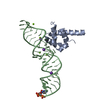

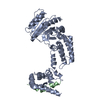
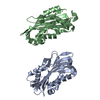


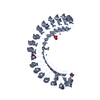


 PDBj
PDBj